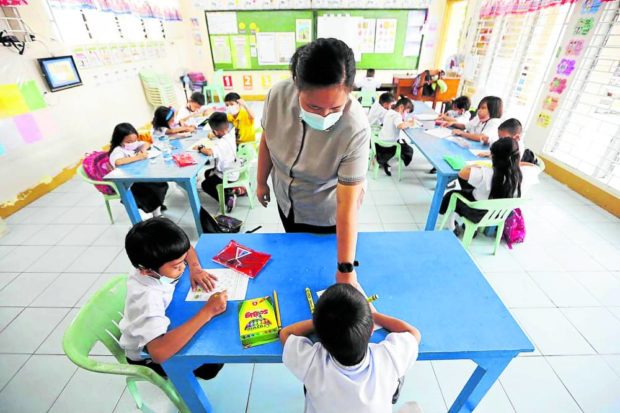
HANDS-ON LEARNING Teacher Ann Mariel Foronda guides a kindergarten pupil in writing his name at Pinyahan Elementary School in Quezon City during the resumption of full in-person classes for public schools on Nov. 2. —NIÑO JESUS ORBETA
Pediatric experts urged teachers, school staff and students to continue wearing face masks in classrooms and indoor facilities to reduce the risk of spreading COVID-19 during in-person classes.
Masking still remains one of the “most competent” infection prevention strategies, said the Philippine Pediatric Society and the Pediatric Infectious Disease Society of the Philippines.
“While there are profound benefits of in-person learning, the threat of COVID-19 among vaccinated and unvaccinated children persists, and so wearing of face masks in indoor school facilities must be continued to decrease the risk of SARS-CoV-2 transmission,” they said in a joint position statement dated Nov. 2.
“Caution dictates the need for universal indoor masking (unless with contraindications) by all students, staff, teachers and visitors to schools, regardless of vaccination status,” they added.
The statement was in reaction to the Department of Education’s policy for optional masking in indoor school facilities.
The two medical societies also recommended optimized ventilation, physical distancing to avoid crowding, hygiene practices, respiratory etiquette, staying home when sick and getting tested as prevention strategies.
“We call on the whole community to keep schools safe and protect students, teachers, staff, visitors and other members of their households, and as such fully support in-person learning,” they added.
Although vaccination for children is not mandatory, the pediatricians said “a considerable number of unvaccinated children are susceptible to the disease.”
“Given the continued risk of transmission in school settings, a high level of infection prevention and preparedness in these settings must continue,” they stressed.
COVID-19 vaccination is currently available for children ages 5 years old and above; boosters are only available for those 12 years of age and above.
Time to reopen
Along with the full resumption of in-person classes in public schools, Science Secretary Renato Solidum called for the country’s further reopening, but maintaining the use of science in living with COVID-19.
Speaking before students from 16 Philippine Science High School campuses holding a sports meet in Baguio City, Solidum said, “our war against COVID is not yet over,” adding that “(we) need to learn to live with the disease with caution [and] with a smile… as we move forward.”
He stressed that science, technology and innovation continue to help local governments manage the disease and transition to the “new normal” while recovering economically.
Case update
“With all these in place, we are now ready to connect [with each other] and I hope the Philippines will continuously ease [public health restrictions],” he said.
The DOH said on Monday that confirmed COVID-19 cases dropped to less than 1,000 daily during the recent long weekend holiday.
An average of 907 cases were confirmed in laboratory tests from Oct. 31 to Nov. 6, which is 30 percent lower than the 1,714 daily detected cases from Oct. 24 to 30.
Out of the 6,346 confirmed infections last week, two were in severe or critical condition. There are 640 admitted COVID-19 patients who are severely or critically ill.
The DOH confirmed 243 more deaths, adding to the official death toll of around 64,000 out of nearly 4 million confirmed cases.
OCTA Research fellow Guido David said that with declining COVID-19 positivity rate at 8.3 percent, reproduction number and average daily attack rate, cases in Metro Manila could dwindle to just 100 daily while the entire country might expect 500 daily cases by the end of November.
He said many Filipinos continue to protect themselves and their vulnerable loved ones by continuing to wear face masks both indoors and outdoors.
David said he hoped the positivity rate could reach 5 percent, which is the maximum testing rate recommended by the World Health Organization for countries that are reopening.
More vaccines
Meanwhile, Paolo Borromeo, who leads the government’s private sector advisory council’s health-care team, said an order of 10 million COVID-19 bivalent vaccine doses will be enough for the administration’s initial procurement plan.
“I think 10 million (doses) is actually a good starting number given the amount or the demand that we are seeing,” Borromeo said, adding that there are ample opportunities to reorder should the country need more supply.
“If we (need) to reorder, it wouldn’t be as difficult as before,” he said, assuring that there is ample supply.
—WITH REPORTS FROM VINCENT CABREZA AND ALDEN MONZON INQ
RELATED STORIES
Wearing a mask in classrooms will be optional – DepEd
Okay to take off masks outdoors – Bongbong Marcos EO